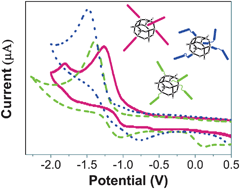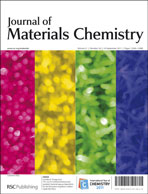A series of oxadiazole-containing molecular hybrid materials with different structures (H1–H5) are controllably prepared by a hydrosilylation method based on the octahydridosilsesquioxane (POSS, T88HH). All these resultant hybrid materials are soluble in common organic solvents, such as chloroform, toluene, tetrahydrofuran, and 1,2-dichloroethane, and possess good film-forming properties. Their structure and properties are characterized and evaluated by FTIR, 1H NMR, 29Si NMR, GPC, TGA, DSC, UV-vis, PL, CV, and elemental analysis, respectively. It is found that the hydrosilylation reaction almost proceeds quantitatively when the feed ratio (molar number of organic monomer to molar number of POSS) is less than 4, at which the resultant hybrids can be controllably prepared by varying the feed ratio. These hybrids possess high thermal stability and good electron injecting properties and an intense blue emission was observed in these hybrids. Simultaneously, it is found that the hybrids (H3–H5) with a strong π electron conjugation effect between POSS and the oxadiazole moiety show higher thermal stability, better electron injecting properties and more intense blue emission than those (H1 and H2) without a π electron conjugation effect between POSS and the oxadiazole moiety.


 Please wait while we load your content...
Please wait while we load your content...